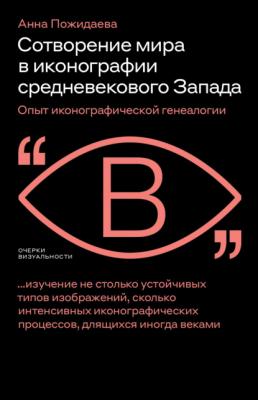ТОП просматриваемых книг сайта:
Сотворение мира в иконографии средневекового Запада. Опыт иконографической генеалогии. Анна Пожидаева
Читать онлайн.Название Сотворение мира в иконографии средневекового Запада. Опыт иконографической генеалогии
Год выпуска 2021
isbn 9785444814857
Автор произведения Анна Пожидаева
Жанр Культурология
Серия Очерки визуальности
Издательство НЛО
36
Ibid. P. 318–326.
37
Martin H. Les esquisses des miniatures // Revue archeologique. T. 4. № 6. Paris, 1904. P. 17–45.
38
Swarzenski H. The Role of Copies in the Formation of the Styles of Eleventh Century // Romanesque and Gothic Art: Studies in Western Art. Princeton: Princeton University Press, 1963. P. 7–18.
39
Hirst M., Bambach Cappel C. A Note on the Word Modello. Майкл Хёрст дает определение этого термина на основе пяти тосканских контрактов с архитекторами, скульпторами и живописцами. Термин применяется, по свидетельству А. Гроте, также и к архитектурным моделям, в частности в XIV в. он использовался в отношении макета Санта-Репарата во Флоренции (Grote A. Studien zur Geschichte der Opera Santa Reparata zu Florenz in Vierzehnten Jahrhundert. München: Prestel, 1959. P. 113 ff).
40
См.: Kessler H. The Illustrated Bibles from Tours; Kessler H. Hic homo formatur. The Genesis frontispieces of the Carolingian Bibles.
41
См.: Weitzmann K., Kessler H. The Cotton Genesis.
42
Alexander J. J. G. Medieval Illuminators and Their Methods of Works. P. 77.
43
Lowden J. The Octateuchs. A Study in Byzantine Manuscript Illustration. P. 102.
44
Degenhart B. Autonome Zeichnungen bei mittelalterlichen Künsten // Münchner Jahrbuch der bildenden Kunst. 3. Folge. 1950. Bd. 1. S. 93–158.
45
Scheller R. W. A Survey of Medieval Model Books. Haarlem: De Erven F. Bohn, 1963.
46
Idem. Exemplum Model-Book Drawings and the Practice of Artistic Transmission in the Middle Ages (ca. 900 – ca. 1470).
47
Ibid. P. 8.
48
Demus O. Byzantine Art and the West. London: Weidenfeld and Nicolson, 1970; Kitzinger E. Mosaics of Monreale. Palermo: S. F. Flaccovio, 1960. P. 133–135; Idem. Norman Sicily as a Source of Byzantine Influence on Western art in the 12 Century // Byzantine art – an European art. Athens: Office of the Minister to the Prime Minister of the Greek Government, 1966. P. 139–141.
49
Мüller M. E. Introduction // The Use of models in medieval book painting. P. XXV.
50
Deuchler F. Der Ingeborgpsalter. Berlin: Akademische Druck- u. Verlagsanstalt, 1967. P. 125–127.
51
Geymonat L. V. Drawing, Memory and Imagination in the Wolfenbüttel Musterbuch // Mechanisms of Exchange: Transmission in Medieval Art and Architecture in the Mediterranean, ca. 1000–1500. Leiden; Boston: Brill, 2012. P. 220–285.
52
Hahnloser H. R. Das Musterbuch von Wolfenbuttel. Wien: Schroll, 1929, Weitzmann K. Zur byzantinischen Quelle des Wolfenbüttler–Musterbuches // Festschrift H. R. Hahnloser zum 60. Geburtstag. Basel; Stuttgart: Birkhäuser Vlg., 1961. P. 223–250; Buchtal H. The «Musterbuch» of Wolfenbuttel and its Position in the Art of the Thirteenth Century. Wien: Osterreichische Akademie der Wissenschaften, 1979.
53
См.: Wirth J. Villard de Honnecourt, architecte du XIIIe siècle.
54
Borlée D. Du dessin à la ronde-bosse: la tête de saint Pierre de Villard de Honnecourt en 3D. Essai d’ histoire de l’ art expérimentale // Les modèles dans l’ art du Moyen Âge (XIIe–XVe siècles). Brugge: Brepols, Turnhout, 2018. P. 151–164.
55
«La prima regola di un puzzle e’ che tutti i pezzi vadano a posto, senza lasciare spazi bianchi fra l’ uno e l’ altro. La seconda, che l’ imsieme abbia senso: per esempio, anche se un „pezzo“ di cielo s’incastrasse perfetamente in mezzo a un prato, dobbiamo con certezza cercargli un altro posto. E se, quando quasi tutti i „pezzi“ sono collocati, e’ gia’ evidente che la scena rappresenta „un veliero corsaro“, un gruppo di „pezzi“ con „Biancaneve e sette nani“, anche se s’incastra perfettamente, appartera’ con certezza a un altro puzzle» (Settis S. La «Tempesta» interpretata. Torino: Einaudi, 2013 (1‐е изд. 1978). P. 73. Пер. А. Б. Езерницкой).
56
Müller M. Introduction. P. XVI.
57
Sheller R. Exemplum. P. 27.
58
Müller M. Introduction. P. XXII; Wolter-von dem Knesebeck H. Göttliche Weisheit und Heilsgeschichte. Programmstrukturen im Miniaturenschmuck des Evangeliars Heinrichs des Löwen // Buchkultur und Golsdschmidkunst im Hohmittelalter. Kassel: Helmarshousen, 2003. S. 147–162.
59
См., напр.: Avril F. A quand remontent Les premiers ateliers laics a Paris? // Les Dossiers de l’ Archeologie. 1976. № 16, P. 36–44; Branner R. Manuscript painting at Paris during the Reign of St. Louis. Los Angeles: University of California Press, 1977; Alexander J. J. G. Medieval Illuminators and Their Methods of Works.
60
Тит Ливий. История римлян 25, 31; Цицерон. О пределах блага и зла 50:19. См.: Sheller R. Exemplum. P. 2.
61
Ibid. P. 2–4.
62
Hist. nat. XXXV. 68.
63
Ibid. P. 62–63. См.: Gallazzi C., Settis S., eds. Le tre vite del papiro di Artemidoro. Voci e sguardi dall’ Egitto greco-romano. Catalogo della mostra (Torino, 8 febbraio – 7 maggio 2006). Torino: Mondadori Electa, 2006. Мы вынуждены заметить, что за время, пока книга готовилась

